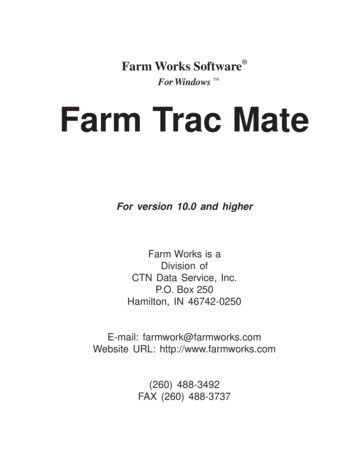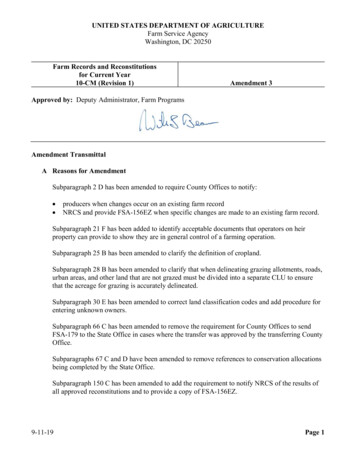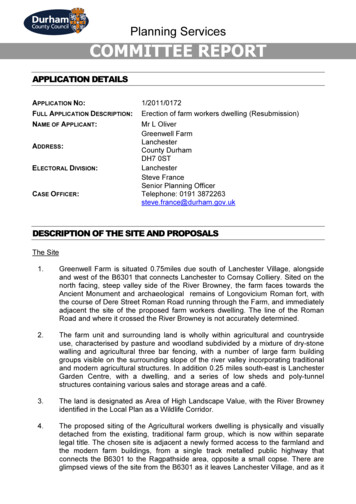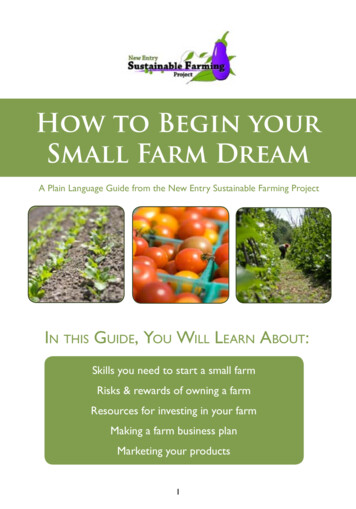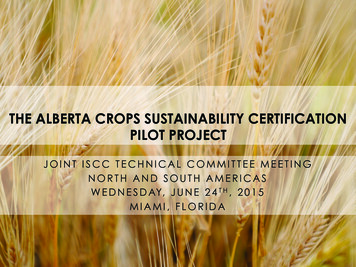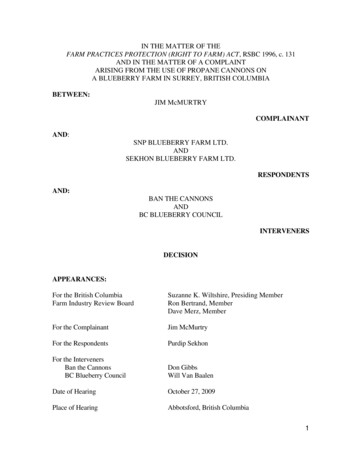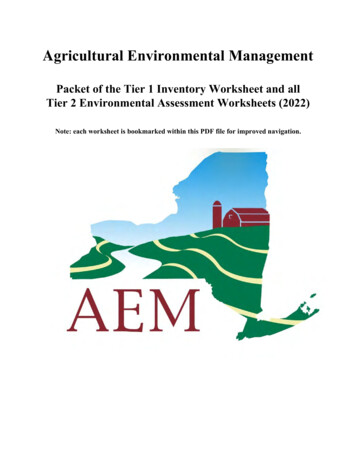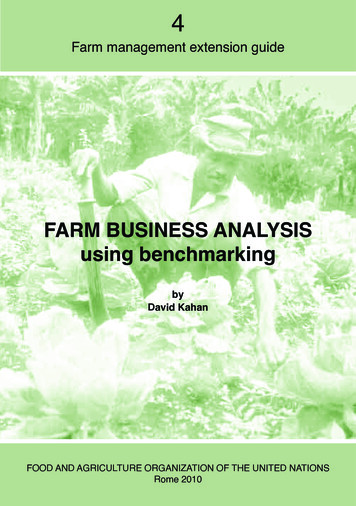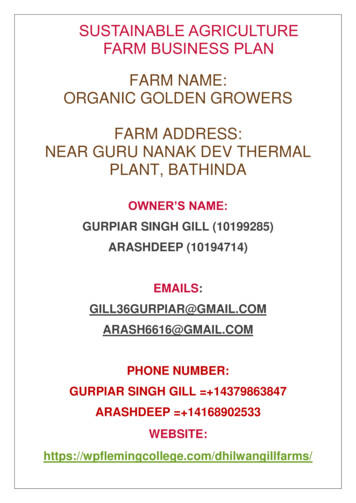
Transcription
SUSTAINABLE AGRICULTUREFARM BUSINESS PLANFARM NAME:ORGANIC GOLDEN GROWERSFARM ADDRESS:NEAR GURU NANAK DEV THERMALPLANT, BATHINDAOWNER’S NAME:GURPIAR SINGH GILL (10199285)ARASHDEEP GMAIL.COMPHONE NUMBER:GURPIAR SINGH GILL 14379863847ARASHDEEP ilwangillfarms/
EXCEUTIVE SUMMARY OF BUSINESS PLANCOMPANY PROFILE . 3BUSINESS OVERVIEW . 3COMPANY HISTORY . 3MANAGEMENT . 3LOCATION . 3LEGAL STRUCTURE . 4Professional Advisor . 4Vision and Mission Statements . 4Goals and Objectives . 4MARKET RESEARCH SUMMARY . 5INDUSTRY PROFILE AND OUTLOOK . 5LOCAL MARKET . 5KEY COMPETITORS/SWOT ANALYSIS .5/6Target Market . 6KEYS TO SUCCESS . 6MARKET SUMMARY . 7PRICING STRATEGY . 7MARKETING STRATEGY . 7Positioning Statement . 7Sales Process . 7Strategic Alliances . 7OPERATIONS. 8LAND MANAGEMENT. 8LEGAL ISSUES . 8/9INSURANCE ISSUES . 9Human Resources. 9Process/Production . 10Crop Production . 10Equipment Resources/management . 11RISK ASSESSMENT . 11FINANCIAL SUMMARY . 12START-UP COSTS AND BREAK EVEN . 12CASHFLOW . 12INCOME STATEMENT . 12Balance sheets . 13/14SUSTAINABILITY INDICATORS . 15SUSTAINABILITY MEASURES AND INDICATORS . 15
COMPANY PROFILEBUSINESS OVERVIEWRice and wheat farm is combination of two crops as the name indicates; WHEAT (Triticum aestivum)and RICE (Oryza sativa). It is joint hand operation of two friends having same goals to grow organicand feed quality crops. We are completely aware that we have millions of competitors but just a fewfarmers grow organically. Thus, we can proudly say that it’s a never-ending business as wheat andrice are the only one that most of population consume These two crops are the commonly grownseasonal commercial grown crops, but we choose organically grown wheat and rice. We have 20acres of land for cultivation of our commercial crops.Company HistoryThis farm was founded in 2017 by Arashdeep and Gurpiar Gill. The Malwa region of Punjab, India,is facing an unprecedented crisis of environmental health linked to indiscriminate, excessive, andunsafe use of pesticides, fertilizers, and poor groundwater quality. The region has been describedas India's “cancer capital” due to abnormally high number of cancer cases, which have increased 3fold in the last 10 years. Studies of this region have also highlighted a sharp increase in many otherpesticide-related diseases, such as mental retardation and reproductive disorders. The mostaffected individuals are the agricultural workers who are directly exposed to pesticides. The Malwaregion of Punjab, India, is less than 15% of the total area of Punjab (only 0.5% of the totalgeographical area of India), but it consumes nearly 75% of the total pesticides used in Punjab. Thehigh use of pesticides, along with environmental and social factors, is responsible for the highconcentration of pesticide residues in the food chain of this region. Moreover, many banned andrestricted pesticides are still in use in this region, warranting strict periodical health check-ups andother interventions. The present review describes occupational, environmental, and social factorsassociated with pesticide use in the Malwa region of Punjab, India, and proposes some riskreduction interventions. so, we planned to have a farm business with organically grown crops whichwould be beneficial for consumers as well as economically sound 259884112 Effects of Environmental Pesticides on the Health of Rural Communities in the Malwa Region of Punjab India A ReviewMANAGEMENTDaily supervision of crops and management of agronomic practices running by both of us. Gurpiaris taking care of marketing and Arashdeep having good hand in accounting and finance.For special advises we prefer faculty of Punjab agricultural university(Ludhiana)LOCATIONOur farm is in Malwa region of Punjab which is in near Guru Nanak Dev thermal plant, Bathinda.This location is outskirt of the city as accordance to rules and regulation and the second major easeis it is near to all the amenities.
LEGAL STRUCTUREThe land is owned under the name of Arashdeep Arashdeep and Gurpiar Singh Gill. We both arelike right hand of each other thus either profit and loss in every aspect would be 100% shared. Professional Advisor: we are agriculture graduates, so we have lot of theoretical knowledgeabout diseases and specific agronomic practices for crops if we talk about professionaladvise then we take advise from expertise of: Punjab Agriculture UniversityDr P.S. Rangi (Marketing) Vision and Mission Statements:Our vision is to share my knowledge and passion for sustainable farming and fresh organiccommercial with consumers and beginners. To create and sustain healthy community byproviding organically grown crops without synthetic pesticides. Along with this, dreamt ofgetting number one rank in organic farming and production.Our mission I have a set of values to achieve this mission. Using organic manures likevermicomposting, green manuring, kitchen garbage etcetera. Organizing weekendworkshops to encourage the newly involving farmers towards sustainable farming and upliftthe net income every year by growing quality crops. Such as; economics says that demandincreases; price of commodities increases automatically which leads to the more grossincome. Goals and Objectives:GOALS – our short-term goal is sell our products at good price so that we can meet our dailyexpenses in long run business. Development and implementation of new marketingstrategies and sales goals.Our long-term goals are the mission statementOBECTIVESour main objective is to produce organic and healthy food for consumers and developingrelationships that enables the farm business to become the preferred supplier to marketsegment.Continually learning to provide grain of superior quality and values that improve the wellbeing of costumer in the specific market.Insuring the farm has the financial capacity to deal with year to year variability in prices andcosts.
MARKET RESEARCHIndustry Profile and OutlookAs the population increases, the demand for cereal crops increases day by day. According to Indianclimate and weather conditions; cultivation of cereals crops like; wheat and rice are much easierand common, but we have planned to grow or these crops organically. Organic farming is quite newspecifically in Punjab and it pays a lot to start an organic farm business that’s why only a few thinksto have organic farm. these days, folks prefer organically grown products because of suddenoutbreaks of deadly disease like cancer. So, the price of organic products is too good thus, one canget high profit from this. The major reason, people prefer wheat and rice as food on the daily basisthus, it is the never-ending business.When it comes to sales, Indian government providing too many local markets in every city andvillages so, it became very easy for every farmer to sell their produce. Even, government has setvery good price for wheat and rice.Local MarketThis farm is only organic farm in Bathinda region so there is no local market to sell organic producethat was why this region is best for doing our business.Key competitors/SWOT AnalysisThis farm is the only farm in that location, so we are only organic producer in our area that was whycompetition will be zero in the market.Strength Agriculture background5 year doing agriculture studyCooperation between partnersHigh demand of organic produceZero competition between marketsGood knowledge of animal husbandryWell educated ownersGovernment support for organic farmingIncreasing of international support fororganic farmingIncrease soil fertilityHigh productionStrong political supportSafe productsNutrient food for communityLong term storage of produceRice and wheat basic food for ourcommunityOpportunitiesWeaknesses Low yields due to weatherLow value addition and Food processingPost-Harvest lossesFood wastageNo access to modern technologyLack of certificationThreats
DiversificationRainfed agricultureOrganic farmingFood Processing SectorBuild up soil fertilityStrengthening rural communityEmployment opportunities.Growing interests in organic farmingHuge regional export marketHuge global export marketSustainable use of resourcesConsistent yieldPromoting healthy lifestyleProduct development Land degradationVariability in Climate patternCrops losses due to weeds, insects,diseasesDeclining Interest in AgricultureGlobal competitionDwindling supply of organic sources ofmanurePest and disease incidenceFluctuations of marketTarget MarketFor our farm wholesale grain market is the target market to sell our produce and flour market to givegrain to them for making flour.Keys to SuccessHard work is the first thing to be a successful in business. There is no shortcut to be successful inshort term. Everyone plays an important role in every part of business whatever we do in business.We both are very positive about our future goals and we do everything to make it possible. Thereare some key things in business to make it successful that are following on; Maintain our speciality like organic farmingFollow rules and regulations of governmentEstablish a loyal customer baseHealth and safety regulationsManage operating riskMaintain set standards of farmGrow volume and salesUse time efficientlyUse capital wiselyPlan for futureProduce high demand productsMake decisions wiselyUse of sustainable resources
SALES AND MARKETINGPricing Strategy“In India the price of an agricultural product can be either the Market Determined Price orthe resultant price after government interventions such as the Minimum Support Pricedepending upon the product. To understand the prices which, follow governmentinterventions, we need to understand these very government interventions in the formof Minimum Support Price.Minimum Support Price (MSP) is a form of market intervention by the Government of Indiato insure agricultural producers against any sharp fall in farm prices. The minimum support pricesare announced by the Government of India at the beginning of the sowing season for certain cropsbased on the recommendations of the Commission for Agricultural Costs and Prices(CACP). MSP is price fixed by Government of India to protect the producer - farmers against excessive fall in price during bumper production years. The minimum support prices area guarantee price for their produce from the Government that this will be the minimum price at whichtheir product will fetch. If the market price is above, MSP, the farmer can obviously sell it at themarket prices. In case the market price for the commodity falls below the announced minimum pricedue to bumper production and glut in the market, government agencies purchase the entire quantityoffered by the farmers at the announced minimum price.”(RAJAN, 2015)Market StrategyWe would harvest our crop when it would have appropriate moisture and would take our cropto the market directly after harvesting so this way, government officers will get attract and ourproduct will get good profit. Positioning statement Positioning statement is very simple in our business plan. As in thecase we are growing organically wheat and rice farm business plan in India, minimum supportprice is set by government and there is no role of farmer in setting prices. Thus, we neverknow what the price of product in the upcoming years would be. Sales Process Our business plan, we need an agent to sell our product. So, it is crucial tohave good relationship with middlemen or agent. Strategic alliances Our association is only with PUNJAB AGRICULTURAL UNIVERSITYfor purchase of seeds, seed certification, organic certification. We take advise from theexperts of university whenever our crop suffer from any disease or malfunction
OPERATIONSLand managementLand management is the process of using land resources. Our responsibility is to use thoseresources into that way so that maximum output can be obtain from farm. We have own 20acres land for doing our business. We need to consider some important factors like watermanagement, soil quality, crop protection and crop rotation etc. we have an organic farm sothese factors important to consider.Water management: Water management is very important factor for land management. Wehave 20 acres of land for growing crops and need to maintain water management for eachcrop in proper way. We grow organic rice and wheat in rotation and maize and berseem.Rice and maize crops more water as compare to wheat and rice because rice and maizecrops are grown in summer and others two are winter crops. We have two tube wells forwatering the crops. We have proper water channels those are attached with tube wells toprovide water to every corner of the field. We have two tube wells each in 10 acres and bothare in the centre of field.Soil quality: Soil is another important factor to consider in land management. Crops growthdepend upon soil quality. In Bathinda region soil is clay loamy soil type in nature which arebeneficial for grain crops because these soils are well drained, moderate and havingmoderate water holding capacity which is ideal for these crops. We need to first check thequality of soil. Make a sample of these soils and these in the soil lab every year for betterproduction every year. We add manures every year which would have an appropriate amountof Nitrogen, Phosphorus and Potassium to increase the fertility of soilCrop protection: Crop protection from weeds, insects, diseases, pests etc. We have anorganic farm, so we need to more concentrate on this factor because in organic farm it canbe difficult to control those crops damaging aspects. So, we need to identify those area wheredamage is start as soon as possible so it is easy to cure that because in organic farm we donot use chemical herbicides and insecticides that are easily control those things in quick time,but we use hand weeding and some biological control to prevent crop from damage. We alsouse some chemical that are certified by government that can be used in organic farm.Legal issuesWe decide to follow each rule to make farm business plan successful. There are someregulations, certifications, contracts, agreements etc.Regulations Follow proper instructions: As we are running an organic farm, so we need to followproper guidelines of government for selling our product in the market. Water quality test: We need to test water quality for better production of crop. We needto submit our water sample to certified government agency of water testing. Proper wage of workers: As per rules of government we need to maintain our standardfor paying our workers to full amount of pay. Safety: Safety factor is very important when we run business. Safety is very essential forlandlord and workers. We need to have a first aid station on the farm because inemergency we can use that in serious issues like accident.Certifications
Organic farming certification in India is governed by The National Programme forOrganic Production(NPOP) under the Ministry of Commerce and Industry.Certifications of seeds first thing to consider because we take certified seeds fromPunjab Agriculture University, LudhianaOur workers have been proper licence of running vehicles on farm like tractorscombine, vehicles etc.We have proper certifications of land where we run the business.Product should be certified under brand name which is Organic Golden Growers.Contracts: Two workers will be contracted for all time availability throughout the year ata fixed rate under contract that will lead to prevention and settlement of any futuremisunderstandings between us and workers.Agreements: As we are working in partnership, so we would get 50% of the profit bothof us out of the total profit according to the agreement papers. We need workers forgrowing season, so we will get agreements for workers during only main season that willlead to prevention of excess use of money and make them aware not to use any sort ofchemicals during working at fields.Insurance issuesCrop insurance: There are two crop insurances going on i.e. Pradhan Mantri FasalBima Yojana and National Crop Insurance Programme (NCIP) / Rastriya Fasal BimaKaryakram (RFBK) but we choose Pradhan Mantri Fasal Bima Yojana for our cropinsurance. “Pradhan Mantri Fasal Bima Yojana:There will be a uniform premium of only 2% to be paid by farmers for all Kharif crops and1.5% for all Rabi crops. In case of annual commercial and horticultural crops, the premium tobe paid by farmers will be only 5%. The premium rates to be paid by farmers are very lowand balance premium will be paid by the Government to provide full insured amount to thefarmers against crop loss because of natural calamities.There is no upper limit on Government subsidy. Even if balance premium is 90%, it will beborne by the Government.Earlier, there was a provision of capping the premium rate which resulted in low claims beingpaid to farmers. This capping was done to limit Government outgo on the premium subsidy.This capping has now been removed and farmers will get claim against full sum insuredwithout any reduction.The use of technology will be encouraged. Smart phones will be used to capture and uploaddata of crop cutting to reduce the delays in claim payment to farmers. Remote sensing willbe used to reduce the number of crop cutting experiments.Unified Package Insurance Scheme: The cover will be for one full year except for Crop Insurance (which will be bi-annualseparately for Kharif and Rabi seasons) renewable from year to year. The Loaned farmerswill be covered through Banks/Financial Institutions whereas non-loaned farmer shall becovered through banks and/or insurance intermediaries.
This policy is designed to take care of the insurance needs of farmers associated withagriculture activities. This policy provides yield-based crop insurance to the farmer based onhis ownership rights of land and sown crop.It covers both the personal assets of the farmer like the dwelling & its contents (Fire), theother assets which help him in earning his livelihood such as Agricultural Pump Sets, andAgriculture Tractor owned by farmer.The policy also provides protection to farmer and his/her family members in case of theAccidental Death / Disablement, accidental insurance protection of farmer's school/collegegoing children and provisioning of education fee to the students in case of death of parent.Life insurance protection to the farmer and his/her family members.The policy will be issued for a period up to 1 year.”(Crop Insurance, 2018)Human ResourcesWe need number of people to work in farm. We need people in growing season andharvesting season. In mid-season we only need irrigation that we can do ourselves. We need10-12 people in growing season of rice when we transplanted the seedlings from the nurseryafter that we need people for weeding. We need people in harvesting season. We need 2-3people in growing season of wheat and 2-3 people in harvesting season. They will be paidaccording to the Indian wage system as in India, there is Rs. 300 per day per worker. Wewould hire only trained worker. In India it is quite easy to find farm labour because we canget them personal relationshipProcess/ProductionCrop production:1. Rotation schedule: We rotate our two crops simultaneously. We grow rice and wheatfor commercial purpose. We grow wheat in winter and rice in summer. We fallow theland for one month after harvesting these crops and that we do some tillage practicesand land preparation for next season growing season. We will add manures and somegreen manuring practices like adding leaves of plants to increase the fertility of thesoil.2. Pest management: Pest management in rice: We use resistant varieties. We will not raise thenursey near lampposts application of neem cake, maintain water level, setuplight traps to monitor pest population to control, keep the field free from grassesand weeds, drain the excess water from the field. Pest management in wheat: Antagonistic insects, organic chemical andnatural resources are used to control or destroy the pest population e.g. Ladybird beetles to control aphids, flooding to control nematodes and neem oils tocontrol nematodes. Basic control methods such as certified healthy seeds couldproduce healthy crops that will have reduced infestations by pests; similarlyusing genetically resistant a tolerant species will also reduce the need of pestcontrol.
Equipment resources/managementWe need number of equipment for running our business. We have own some equipment andsome we are renting from other agencies. The equipment’s that we have: Hand tools like steel hoe, sprayer, rake, shovel, sickle etc Tractors and trolleys Disc harrow Cultivator Seed planter Plank Furrow maker Seed drillEquipment which is not having yet(rent) We are renting some other equipment’s from others like combine, straw maker, roller, rotatoretc for harvesting Management of equipment is very important because we need equipment every year, so itsmaintenance is very important, cleaning the equipment is very necessary after every growingseason.Risk Assessment1.2.3.4.5.Risk Is the something involving to the danger. There are several types of risk in farm businessare following on:Production Risks: Includes whether, insets, disease, technology and other event that aredirectly affects production quality and quantity.Price Risk: Uncertainty in the Market for commodities such as changes in the prices of inputsor outputs.Financial Risk: The method in which capital is required and financed and the firm’s ability topay financial obligation.Institutional Risk: Changes in Governmental or legal policies which affects the agriculture.Personal Risk: Risk common to all Businesses, such as death, injury/ disease to the farmer/ proprietor.(Reddy, 2015)There are three step approaches for risk management: Reduce risk: In this approach asses potential risk on the farm and create plan tomitigate risks. The farm will have all the risk avoiding factors such as worker training,safety for vehicles and farm workers etc. can reduce the chances of accidents a loss. Manage risk: This is the approach that manage if any sort of risk occurs means thatwe can take care if any accident with employee or worker happens, company canprovide first aid and other facilities. Transfer risk: We can transfer risk by taking some crop insurance coverage foraccidents and emergencies. For example: we take Pradhan Mantri Fasal Bima Yojanaand Unified Package Insurance Scheme.
FINANCIAL MANAGEMENTStart-up costs and Break evenStart-up cost are the expenses incurred during the starting of new business.Breakeven point comes when are income and expense are same.CashflowIn cash flow we receive money 2 times in a year first with selling of wheat is Rs. 6,71000 andfrom rice in receive money in month of October after selling is Rs. 11,70000.In cash out flow all the expenses are included like seeds of both crops Rs.160000, harvesterrent Rs.40000, labour cost Rs.100000, transportation cost Rs. 50000, manures Rs. 42000and some other miscellaneous costs Rs. 20000 are included.Income statementOur income statement it shows our revenue, expenses and it calculate us a net income thatis 14,29000 and our net margin is 0.78%.
Balance sheetsThere are two balance sheets one from starting from year and one from end of the yearthose describe our assets and equity. We are working in the partners so we both equallyinvest money in our farm business plan.
SUSTAINABILITY INDICATORSSustainableindicators/measuresSpecific goalsWhat actions willyou take to reachthis specific goal?How will youknow when youhave reachedthis goal?When do youplan to havereached thisgoal?EnvironmentalHealthOrganic farmingCertification oforganic farmingSince to startour businessEconomicProsperityNet profit higherthan inputsWe will not applyany conventionalfarmingoperations.Keep focusing onall the on farm andoff farm operation.When we willget incomestatement.Social, Cultural,Economic EquityGenerate theresources to meetpeople’s needsWe will give ourbestConsumerfeedbackIn the end ofthe yearduringfinancialprojection.After 2-3years.(sustainability Goals and Measures, 2018)References(2018, 10 22). Retrieved 4112 Effects of Environmental Pesticides on the Health of Rural Communities in the Malwa Region of Punjab India A ReviewCrop Insurance. (2018, 11 28). Retrieved from vikaspedia: op-insuranceIndia - Market Entry Strategy. (2018, 10 10). Retrieved from export.gov: https://www.export.gov/article?id India-marketentry-strategyRAJAN, G. U. (2015, 11 20). How are prices of agricultural products decided in India? Retrieved from cultural-products-decided-in-IndiaReddy, K. P. (2015, 10 26). Risk Management in Agriculture. Retrieved from The Hans /182531Risk Management in Agriculture. (2018). Retrieved from the hans india: sustainability Goals and Measures. (2018). Retrieved from Fleming College D2L: /pauander flemingcollege ca/ layouts/15/Doc.aspx?sourcedoc %7B6f5bb593-3c4a-47a2-876f-6596a9ac1e58%7D&action default
farm business plan farm name: organic golden growers farm address: near guru nanak dev thermal plant, bathinda owner's name: gurpiar singh gill (10199285) arashdeep (10194714) emails: gill36gurpiar@gmail.com arash6616@gmail.com phone number: gurpiar singh gill 14379863847 arashdeep 14168902533 website:
